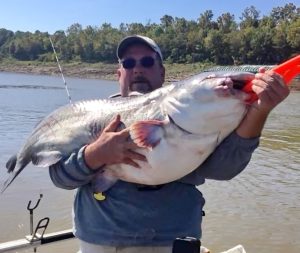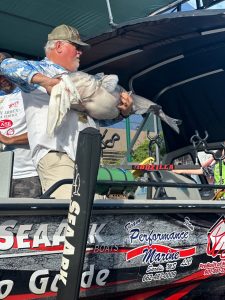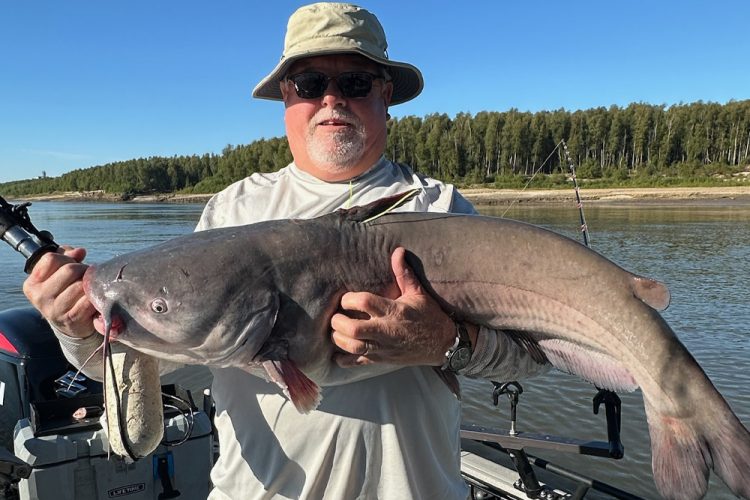Trophy catfish like this one being held by Captain David Magness of Cat’n Aroun’
Guide Service are easier to catch when you find the proper structure those fish
live in and present your bait properly.
Improving Your Success by Fishing Wood Structure in Rivers
By Rodney Crimm
Whether you are looking to improve your success on your favorite river or trying to figure out a new river these tips should help.
We all have either struggled on our favorite river or gone to a new river and have been left scratching our head on where we should start our search for locations to fish. If you use some of the tips shared in this article by two very accomplished and experienced anglers, you could be on the way to being more successful in the future.

Wood structures in a river can be excellent locations to find big catfish no matter what the size of the river. Captain David Magness, owner of Cat’n Aroun’ Guide Service from Hernando, Mississippi, says he is always looking for wood structure no matter where he is fishing. He said, “It does not always need to be a big pile of wood to hold big trophy size fish.” He has found that isolated logs or root balls often hold more large fish than a whole treetop.
Magness likes to try bumping over that structure if the current conditions are right for that technique. However, he says, “If the current isn’t right for bumping or if you have marked fish around that isolated structure and bumping it didn’t produce a bite, then you should try walking baits to the log or root ball from a spot-locked position to keep the bait in the strike zone longer.”
Magness’s preferred rig when anchor fishing is a simple Carolina rig with a sinker slide above the swivel. This allows easy weight changes to adjust for varying current conditions in different locations. He varies his leader length to present baits at different depths off the bottom. For his bumping rigs, he uses a three-way setup with a 16– to 20-inch lead line off the bottom of the swivel and a 30– to 40-inch hook leader. His weight will be as light as possible for the current conditions that he is fishing. He wants to have enough weight to get his bait down quickly and keep contact with the bottom, but light enough to be able to move the bait out behind the boat as he drifts.
Magness uses skipjsack baits for trophy fish in the warmer months, but he likes big gizzard shad for his cut-bait in colder temperatures. The fish can be more closely related to the wood in cooler temperatures than what they might be when more active in warmer temperatures.

Jamie Bardsley from Perry, Arkansas is an accomplished tournament angler and tournament director for Arkansas Area Catfish Hunters tournament trail. He has been chasing trophy catfish for over 40 years. He regularly fishes the Arkansas, White and Mississippi rivers.
He said, “When fishing the Arkansas River and rivers of similar size, my best luck comes from spot-locking or anchoring above wood structure and walking baits back to the structure.” He uses a line-counter reel and GPS to know how far from the structure to properly position his baits. He prefers to bump along the outer edge of the wood that he finds using the side imaging on his electronics. He tries to pull those fish out of the structure and avoid bumping through the heaviest wood and losing more tackle.
Bardsley’s preferred rig for bumping includes a custom three-way rig with swivels to prevent line twist and tangles, an 8-to 12-inch sinker leader on the bottom of the three-way rig and a 4- to 6-foot hook leader with a float and rattles that he makes to help keep his bait up off the bottom and out in front of his weight.
Experience has shown him that use of a longer hook leader when bumping keeps your bait more stable as you are lifting the weight off the bottom to move it while drifting.
If you are bumping well behind your boat and your rig gets caught in some structure, he recommends that you just let it sit there and reel line up as you get closer. A fish may come along and pull you free. But if that doesn’t happen, then it is easier to break off with less line out. He prefers to fish where current is a little slower so a 3– to 4-ounce weight can be used.
Good locations to look for wood structure in rivers include sloughed-off banks where trees have fallen into the river, mud banks where wood sticks to the bottom of the river, inside bends of the river and banks upstream from outside bends in the river. Bardsley,, like Magness, looks for wood in the 30- to 50-foot range, and it is a bonus if that wood happens to fall along a defined ledge dropping into deeper water.
Wood structure can produce some big catfish. You might have to learn more about finding it on your favorite river and then figure out what technique to use to put your bait in the proper location. But the tips David Magness and James Bardsley have shared here can improve your success.
Be sure to always be safe on the water and, any chance you get, take someone along with you that has never experienced catching a trophy catfish. Landing one of these brutes gives you a great feeling that’s remembered for a lifetime.
(Rodney Crimm of Pontotoc, Mississippi is a B’n’M Pro Staff member, catfish tournament angler and lifelong outdoorsman with a passion for catching trophy catfish.)



